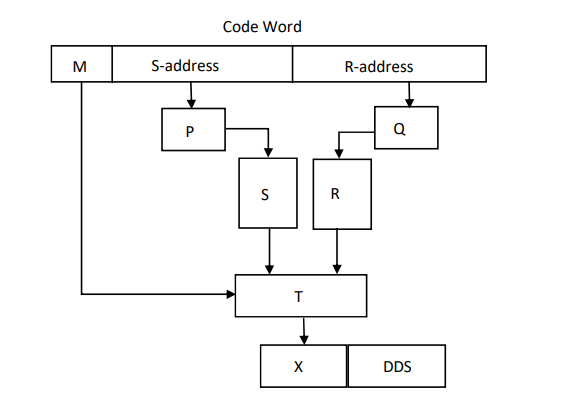Ques 1: Let R1 and R2 be two 4–bit registers that store numbers in 2’s complement form. For the operation R1 + R2, which one of the following values of R1 and R2 gives an arithmetic overflow?
GATE 2022 Q no 18
(A) R1 = 1011 and R2 = 1110
(B) R1 = 1100 and R2 = 1010
(C) R1 = 0011 and R2 = 0100
(D) R1 = 1001 and R2 = 1111
Ans: (B) R1 = 1100 and R2 = 1010
Solution: If two numbers are represented using 2’s complement method with n bits then condition for overflow is
- If the sign of addends are the different then Overflow never occurs.
- if the sign of addends are the same and the sign of sum is also same as of addend’s sign, then Overflow never occurs.
- if the sign of addends are the same and the sign of sum is different from addend’s sign, then Overflow occurs.
Here in option B,
1100 + 1010 = 10110
After adding carry i.e. 1 to sum i.e 0110, the sum will be 0111
Check the sign i.e MSBs of numbers
Here sign of first number(1100) is -ve, sign of second number(1010) is negative and sign of result (0111) is positive.
So Overflow occurs
Ques 2: Consider a digital display system (DDS) shown in the figure that displays the contents of register X. A 16-bit code word is used to load a word in X, either from S or from R. S is a 1024-word memory segment and R is a 32-word register file.
Based on the value of mode bit M, T selects an input word to load in X. P and Q interface with the corresponding bits in the code word to choose the addressed word. Which one of the following represents the functionality of P, Q, and T?
GATE 2022 Q no 40

(A) P is 10:1 multiplexer; Q is 5:1 multiplexer; T is 2:1 multiplexer
(B) P is 10:210 decoder; Q is 5:25 decoder; T is 2:1 encoder
(C) P is 10:210 decoder; Q is 5:25 decoder; T is 2:1 multiplexer
(D) P is 1:10 de-multiplexer; Q is 1:5 de-multiplexer; T is 2:1 multiplexer
Ans: (C) P is 10:210 decoder; Q is 5:25 decoder; T is 2:1 multiplexer
Solution:
S is 1024 word memory segment, So it needs 10 address lines.
So, P is a decoder with 10 input lines and 210 output lines.
R is 32 word memory segment, So it needs 5 address lines.
So, Q is a decoder with 5 input lines and 25 output lines.
Based on M, T selects an input word
So it must be a 2:1 Mux
Ques 3: Consider three floating point numbers A, B and C stored in registers RA, RB and RC, respectively as per IEEE-754 single precision floating point format. The 32-bit content stored in these registers (in hexadecimal form) are as follows.
GATE 2022 Q no 41
| RA= 0xC1400000 | RB = 0x42100000 | RC = 0x41400000 |
Which one of the following is FALSE?
(A) A + C = 0
(B) C = A + B
(C) B = 3C
(D) (B – C) > 0
Ans: (B) C = A + B
Solution: Given that Numbers are in IEEE-754 single precision.
Representation is : 1 sign bit, 8 exponent bits and 23 Mantissa Bits
Decimal value=(−1)Sign bit×(1.Mantissa)×(2)exponent−127
RA=0xC1400000=11000001010000000000000000000000
RA=0xC1400000= 1 10000010 10000000000000000000000
Decimal value of RA=(−1)1×(1.1000000000..)×(2)130−127=−(1100)2=−12
Similarly, RB = Ox42100000=01000010000100000000000000000000
RB = Ox42100000=0 10000100 00100000000000000000000
Decimal value of RB=(−1)0×(1.001000000000..)×(2)132−127=−(100100)2=36
And RC=0x41400000=01000001010000000000000000000000
RC=0x41400000=0 10000010 10000000000000000000000
Decimal value of RC=(−1)0×(1.1000000000..)×(2)130−127=(1100)2=12
So, C=A+B is False.